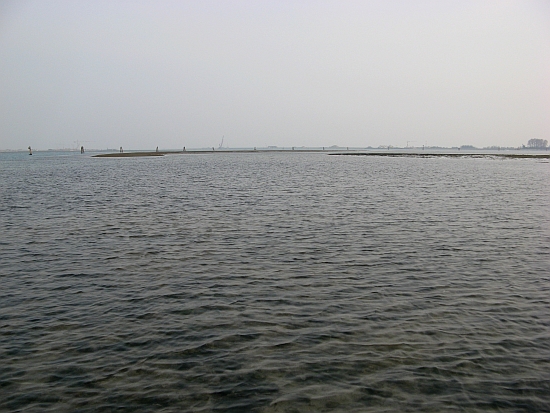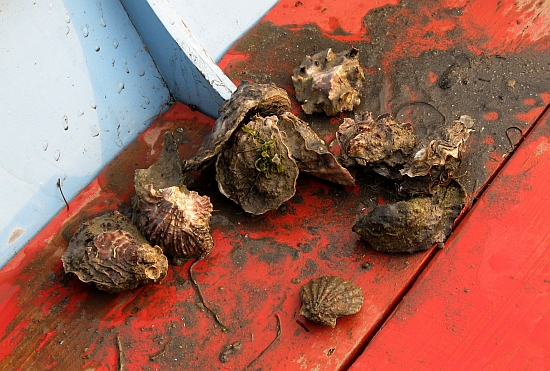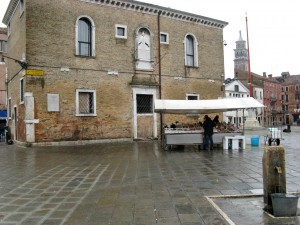We went out rowing the other afternoon, which is always a good thing but not exactly news. Other people might have been unenthusiastic — and in fact, we didn’t see anybody else out — but we don’t wait for the weather to sing its little Lorelei song. That’s a waste of valuable time especially in March, what with Lorelei being so skittish. We just go.

For a while, the most notable thing about the excursion was the faintly hazy, vague color scheme of the part of the lagoon where we like to go. Then the breeze began to get to me. It wasn’t so strong, but it was raw and insistent, which began to be annoying, like a crying baby in the apartment at the end of the hall. Part of the effect of the crying baby, as with the wind, is that there’s pretty much nothing you can do about it. Things I can’t do anything about really, really annoy me. Just so you know.
But the situation became much more interesting when we ran the boat onto the exposed mudbank — the tide was out — so Lino could go exploring. I would have gone too, but wasn’t wearing shoes that would have made even the slightest effort to resist the squishy, waterlogged terrain.
And what he found were oysters. I knew they were out there because he’s brought them home before. Lagoon oysters on the half-shell were our antipasto for Christmas Eve dinner a few years ago, and they are delectable, not too large, not too small, and faintly sweet. One source states that this breed is known for its “unique tannic seawater flavor…and [is] considered excellent for eating raw on the half shell.” As I said.
To be precise, these unsung lagoon creatures are known elsewhere as the highly prized Belon oyster, the stuff of high-wattage chefs and cultivated feeders. Here, nobody cares about them anymore. Even less than not caring, nobody seems to even know they exist. Here the restaurants are fixated on clams…clams…clams…clams, like a stuck culinary record.

Oysters were once as common in the market as clams. A particularly Venetian habit, more firmly rooted than kudzu, is to exclaim “Ostrega!” (OSS-tre-gah) which means “oyster” in Venetian. (Italian: ostrica). It’s an all-purpose term that would instantly reveal you to be Venetian anywhere in Italy; in fact, it carries amusing overtones of charming quaintness to anyone not from here. It is one of those clever next-to words (like “hello” instead of “hell”) that people employ to avoid using a really serious and socially inadmissible word — in this case, “ostia,” which is the Communion wafer. Ostrega is close enough to get your meaning across without offense.
“Ostrega” is a flexible word which, depending on your tone of voice, can express a variously emphatic reaction from astonishment to agreement, disbelief, displeasure, wonder, delight, and so on. “Ostregheta” (OSS-tre-GHE-ta, or “little oyster”) is a gentler variation. I have a Venetian friend who will sometimes say “OO-strega,” which I think is adorable. I keep meaning to ask him if he invented this.

Back to the oysters themselves. One of the clauses in the numberless regulations governing fishermen (which began to be documented in 1270), as stipulated in 1765, stated that “To only the fishermen who personally exercise the laborious toil of fishing, should remain the usual freedom to go to the neighborhoods selling fish at retail such as eels, flounder, mullet, sardines….cuttlefish, clams and oysters in the permitted times.”

But now, as with so many things (such as papaline), they have fallen out of favor and I’m not sure anyone can say why. There seem to be fashions in fish. It can’t be because oysters are difficult to collect, because they’re generally easier than clams. Clams lurk beneath the sediments, but oysters — like canestrelli — are often found lying there on the muddy/sandy bottom, right out in the open, not even trying to hide. You can just pick them up, like Lino does, though back when they had commercial value men would take them by means of a cassa da ostreghe, more simply known as an ostregher (oss-treh-GHEHR).

An ostregher was a sort of baggy net weighted with a strip of iron which was tied to the stern of your boat, and which you would drag along the bottom as you rowed or sailed. Something similar, called a “cassa da canestreli” or “scassa diavolo” was used to take canestrelli (Pecten opercularis), as Lino often did when he was a lad; he sometimes shows me where, along the edges of the Canale del Orfanello stretching from the Bacino of San Marco toward the island of San Servolo. Or in the Canale del Orfano, from San Servolo to the island of La Grazia. Lots of people did this, just for themselves. Even now, a few people might still joke, when the vehicle you’re in (say, the vaporetto) is slowing down for no apparent reason: “Are they dragging a cassa da canestreli?” I imagine that most youngsters have no idea what they’re talking about.

Then the city outlawed this technique as damaging to the lagoon. You might say this was a good thing — it’s certainly fine as a concept, like peace on earth — except that it wasn’t damaging, and if it were, why was this method outlawed while illegal clamming continues, night and day, by people using a mechanized version of basically the same technique, leaving utterly barren, completely devastated tracts of lagoon behind?
Lino happily returned to the boat with a bag containing a batch of oysters and a lone canestrelo which he couldn’t resist.
All now frozen solid, awaiting their moment of glory in Lino’s next fish soup.
It turned out to have been, as the saying goes, an excellent day to die. For the oysters, I mean.

